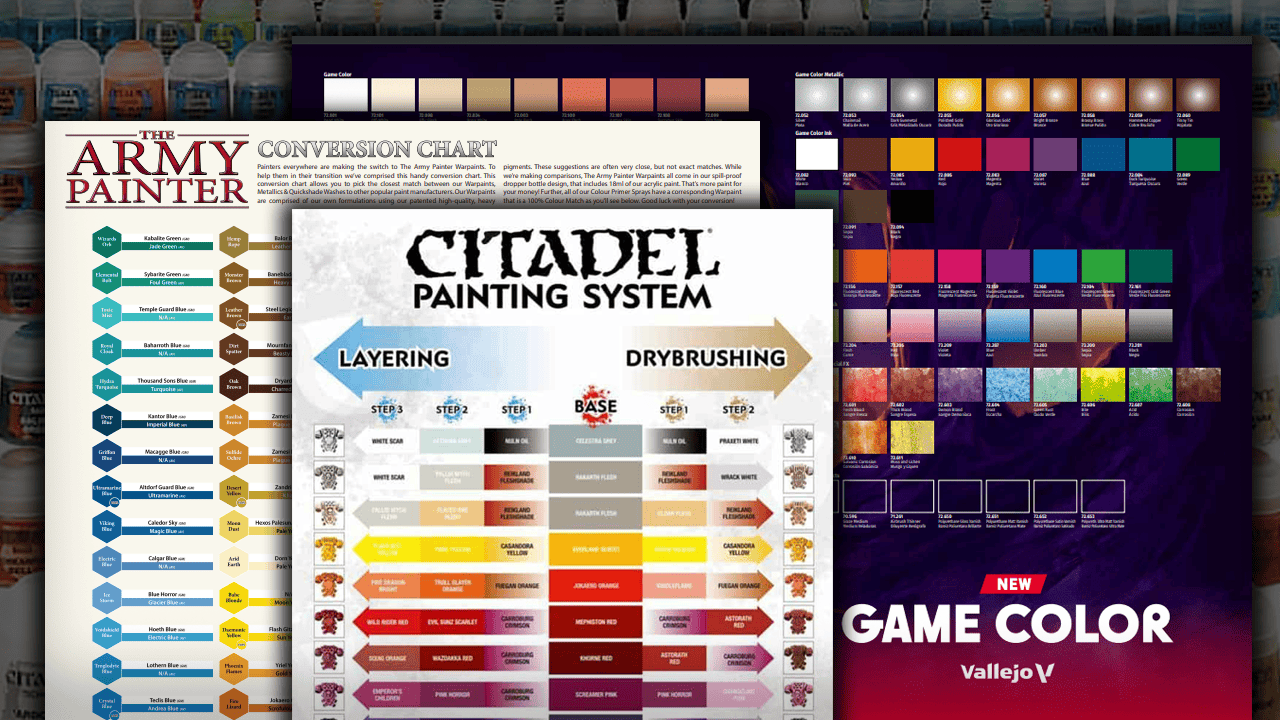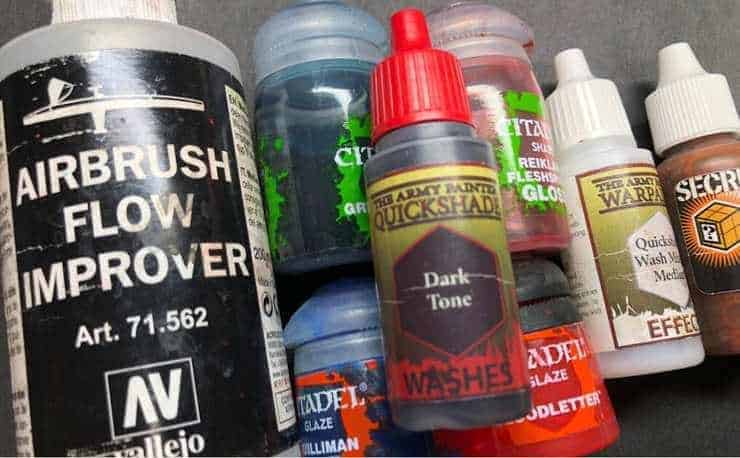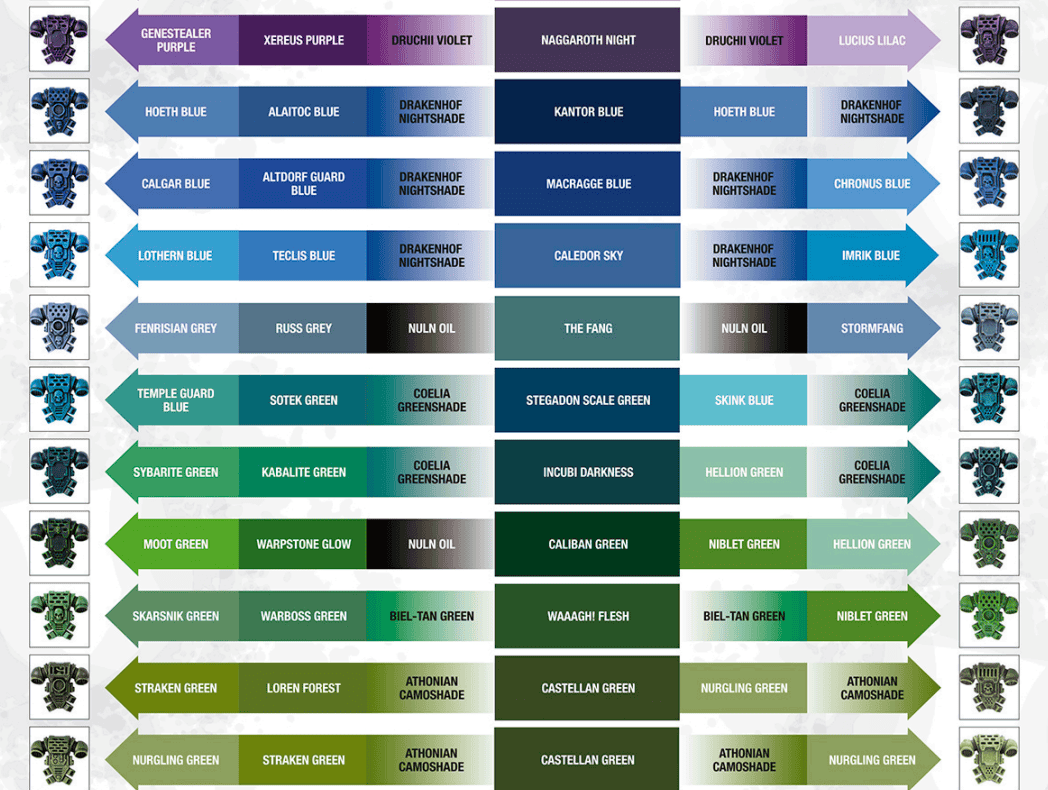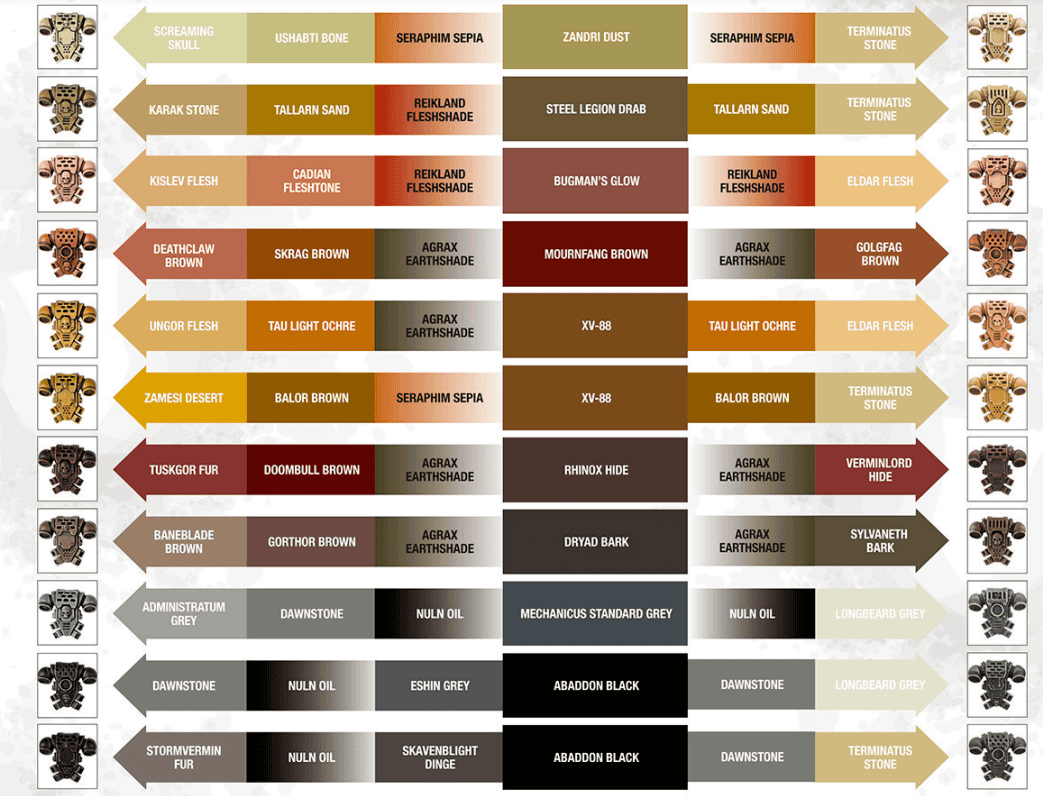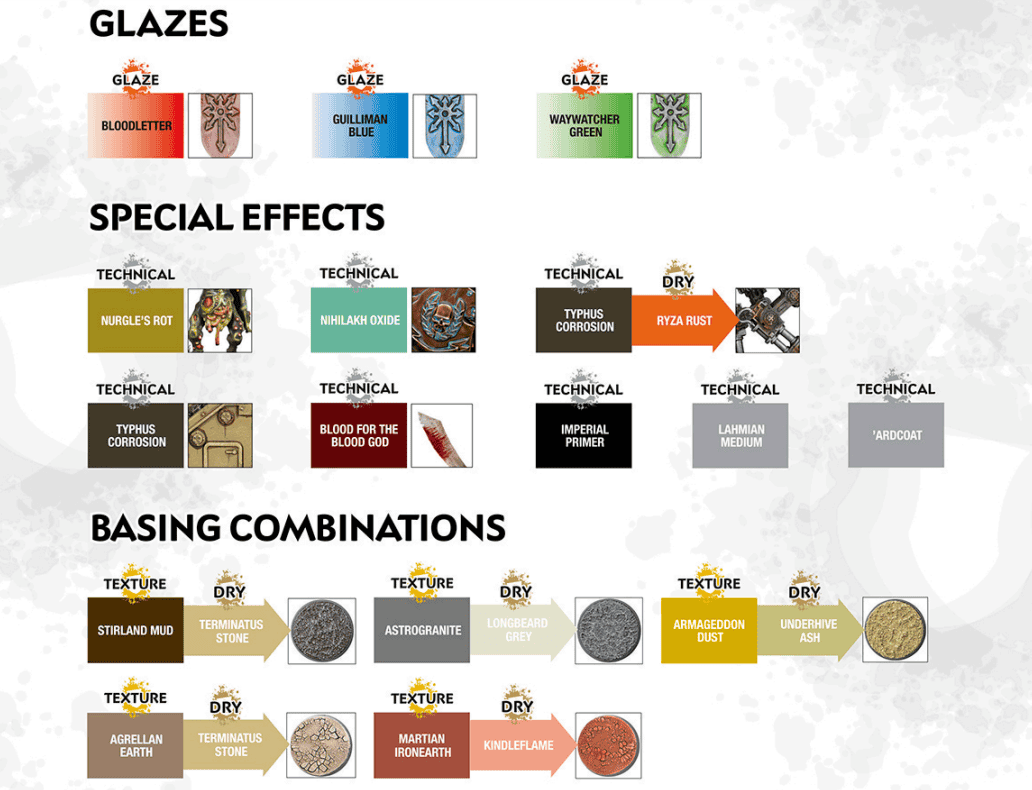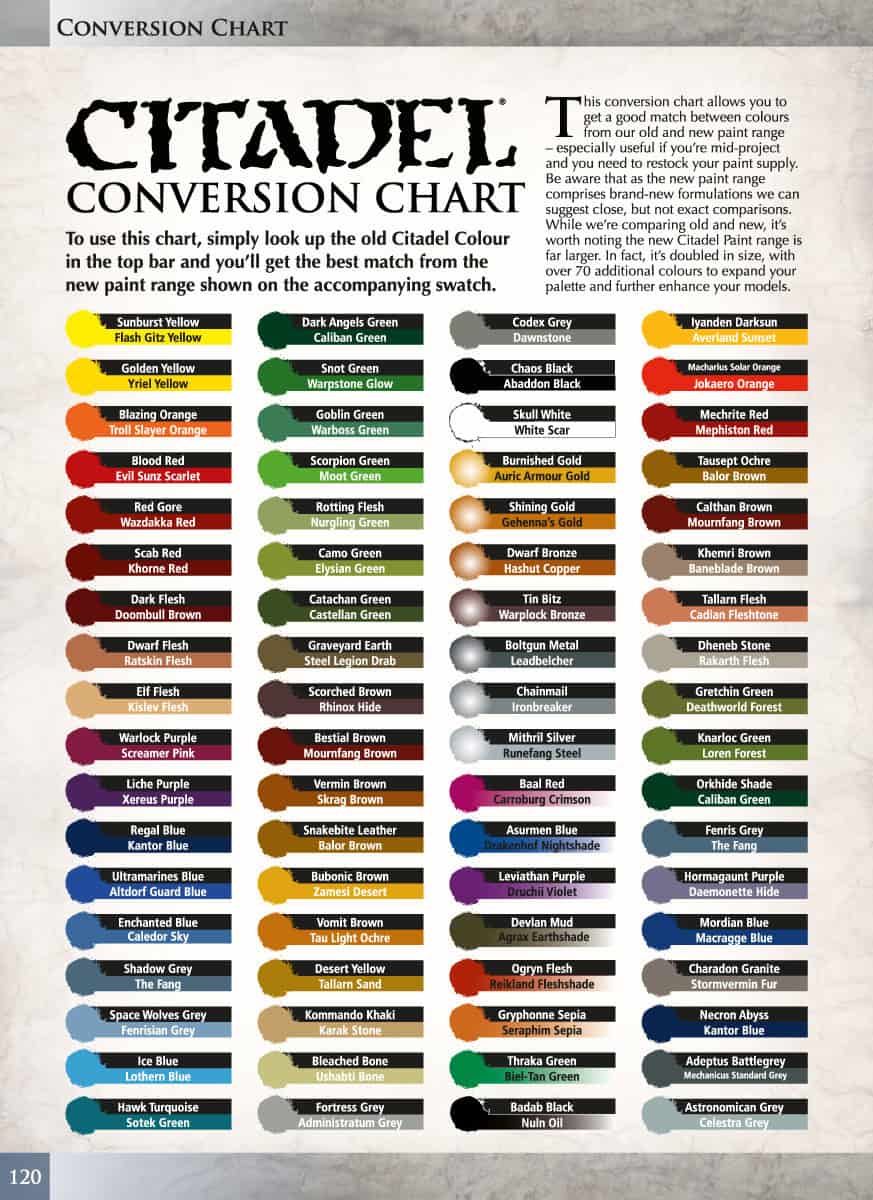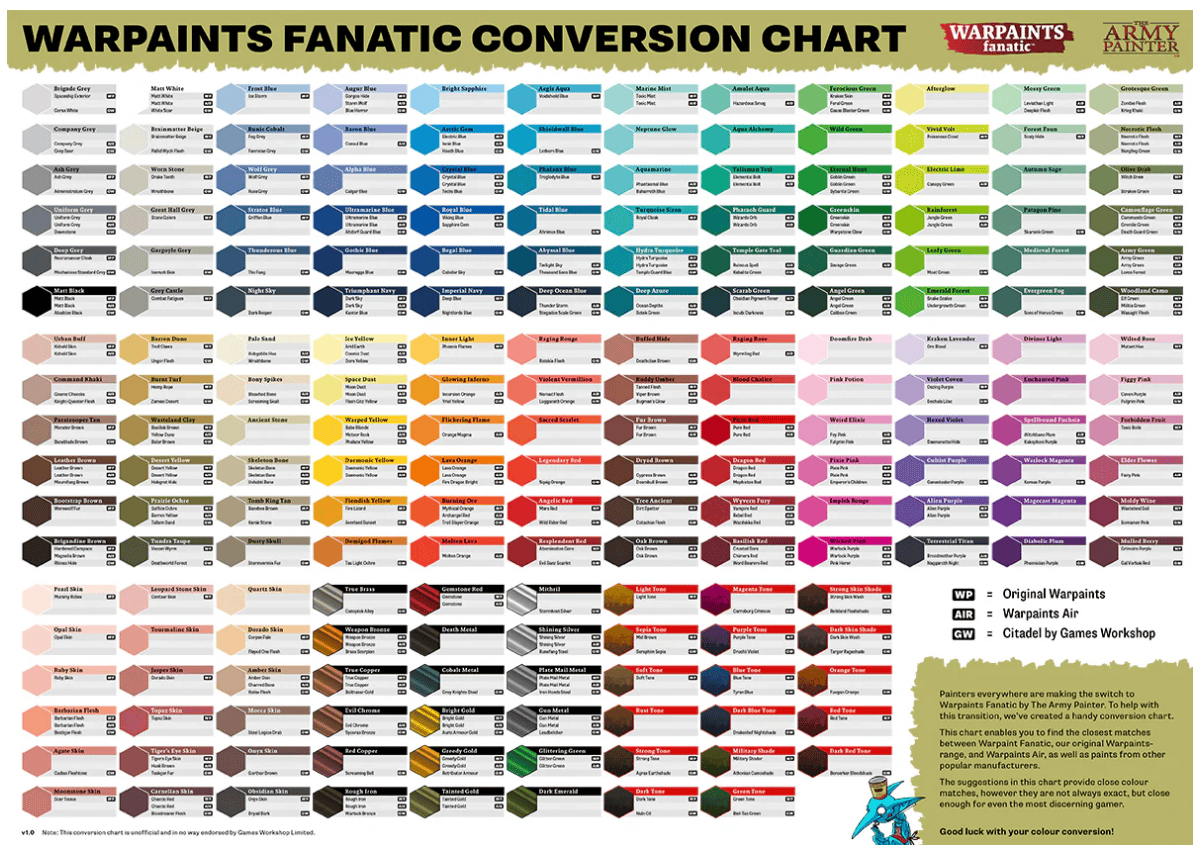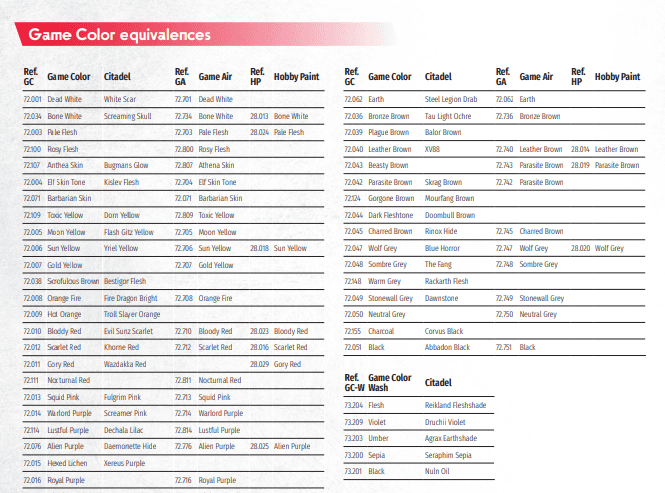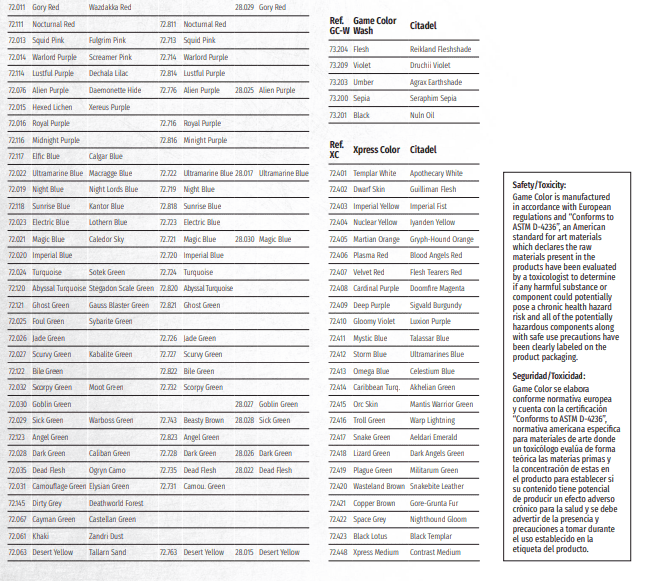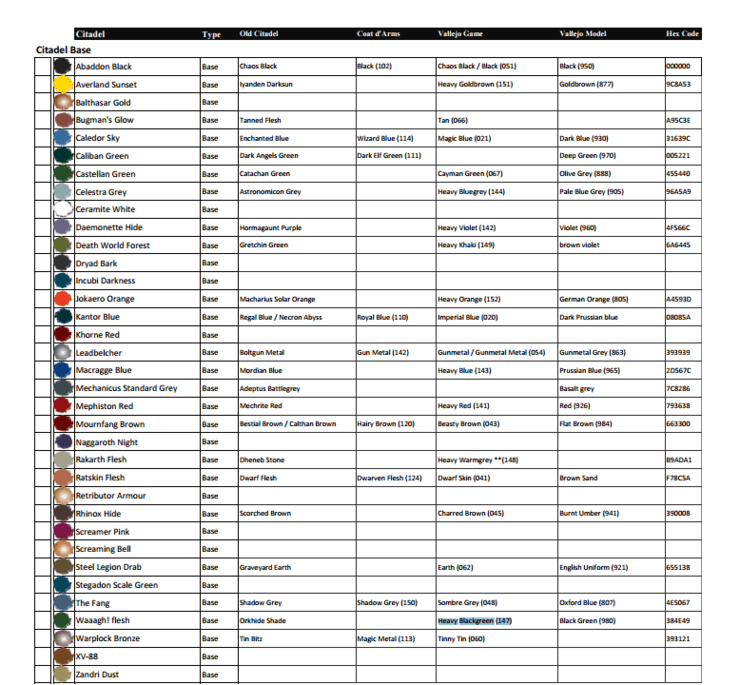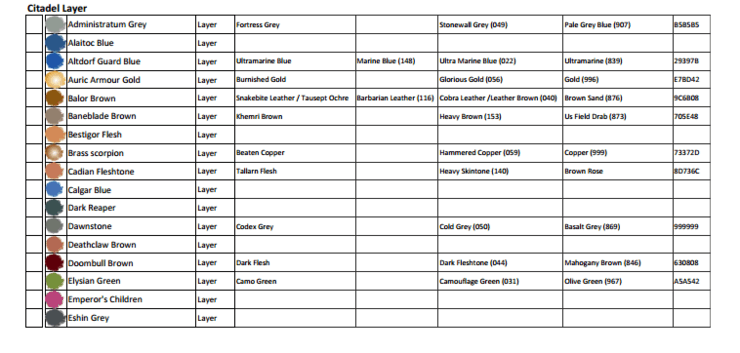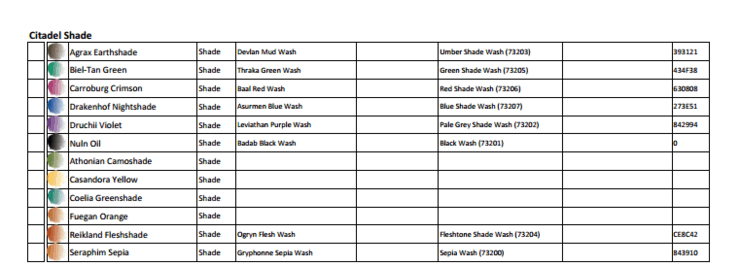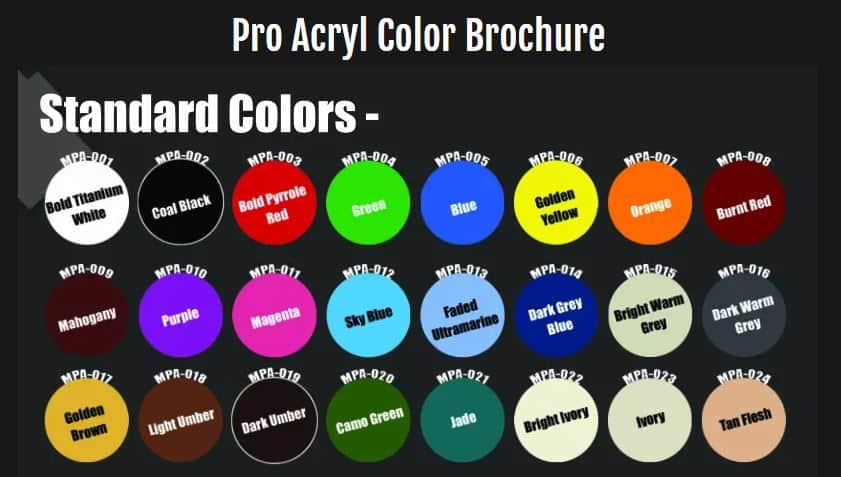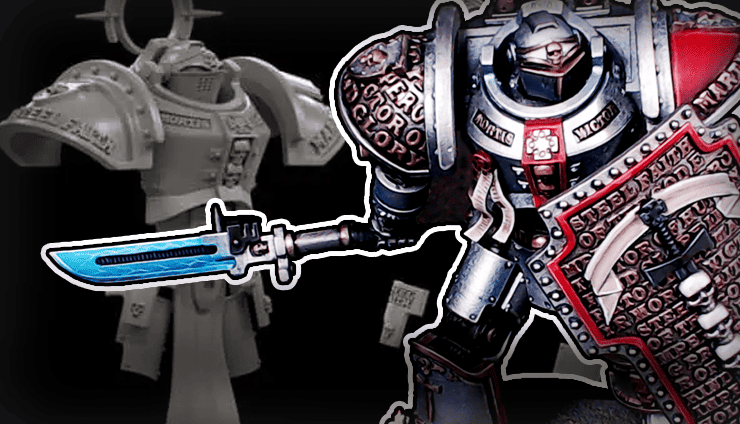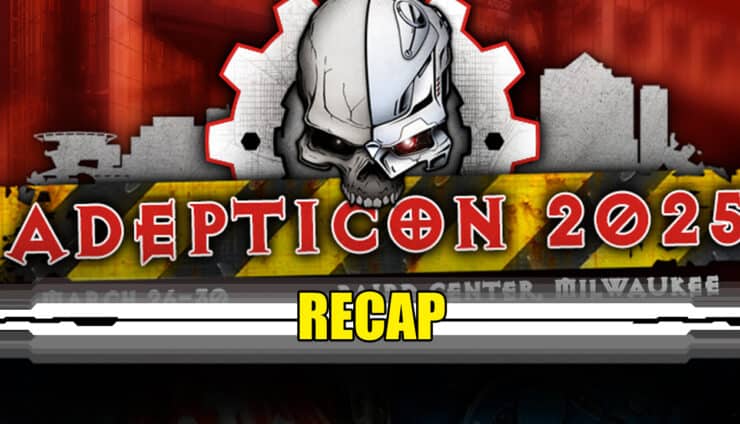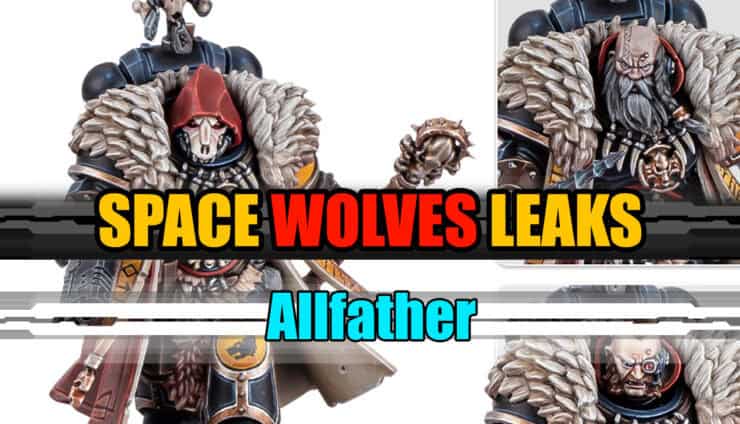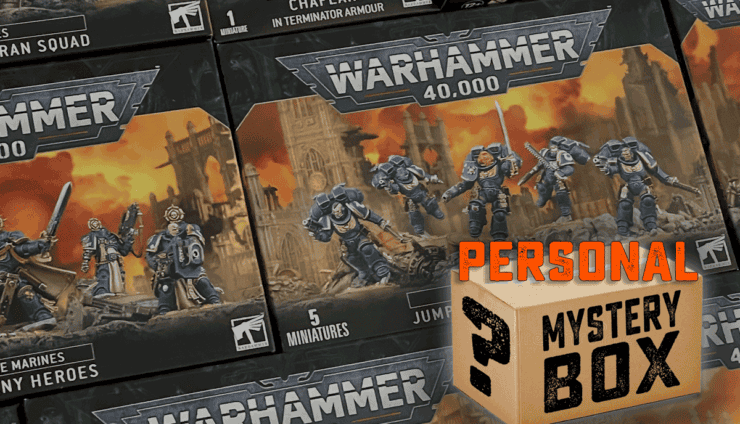Find the best Citadel paint conversion charts for Army Painter, Vallejo Games Color, Two Thin Coats, and simplify your miniature painting!
Updated May 8th, 2025, by Rob Baer with updated information and links to relevant content, as well as the Two Thin Coats paint conversion charts and Colour Forge.
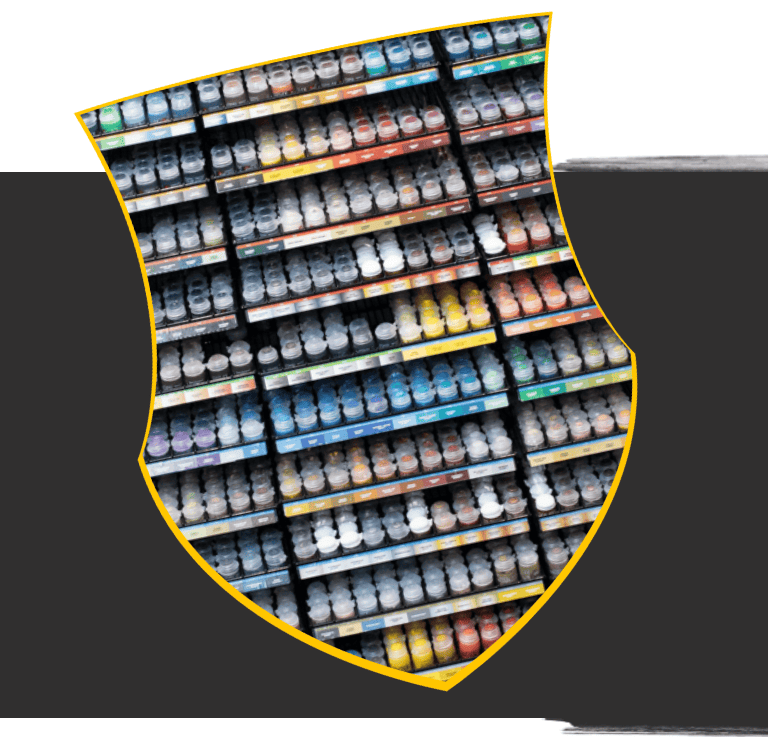
Miniature Paints & Color Conversion Charts
These handy guides are like the Rosetta Stone of the painting world, translating colors between Citadel, Army Painter, Vallejo, paint color charts, and beyond. Whether you’re trying to keep your Imperial Guard regiment looking sharp or finding the right chameleon shimmer for a cyberpunk mini, we’ve got you covered.
What Are Acrylic Miniature Paints?
Miniature paints are the lifeblood of any miniature painter’s toolbox. They come in a dazzling array of colors, finishes, and styles, specifically designed to help you bring tiny armies, monsters, or intricate fantasy worlds to life. Unlike your typical DIY paint, these are formulated for detail and precision.
At the heart of the miniature painting scene, you’ll find popular brands like Citadel, Army Painter, and Vallejo. Each company offers its unique spin on what a perfect paint should be, which can lead to some real head-scratching when you’re trying to match up colors across brands.
And let’s be honest, at some point, we’ve all had to make that terrifying leap from one paint range to another. That’s where the beauty of paint conversion charts for Citadel, Army Painter, and Vallejo comes into play.
Why You Need Paint Conversion Charts for Miniatures
Let’s talk about the elephant in the room: paint conversion charts. If you’ve been painting for a while or you’re just starting, you’ve probably run into the situation where you can’t find the exact shade you need in the brand you usually use.
It’s like looking for a lost sock in a laundry pile—except that sock is “Lothern Blue,” and it’s out of stock. Enter the paint conversion chart, the ultimate lifesaver for painters.
Paint conversion charts give you an easy way to find equivalent colors across different paint ranges, so you don’t have to worry about whether your Army Painter Dragon Red matches Citadel’s Khorne Red.
These charts are especially helpful when you want to replicate an exact color scheme but don’t have access to a particular brand or when one of your go-to colors has been discontinued—a tragedy that every seasoned painter has faced at some point.
Matching Colors Across Brands

A Citadel paint color chart might show you that their “Nurgling Green” is the perfect blend for a sickly monster, but if you’ve only got Vallejo paints in your stash, you’ll need to hunt down the equivalent.
A solid paint conversion chart helps take the guesswork out of this process, offering a reference point for finding that perfect Vallejo to Citadel conversion or how to switch between Army Painter and Citadel without losing the tone you’re aiming for. No more staring at bottles trying to eyeball the closest match under your desk lamp—just check the paint charts below.
Time-Saving for Miniature Painting
There’s no denying that painting miniatures can be a time-consuming hobby. Between priming, base-coating, shading, layering, and detailing your paint job can take hours. Having a reliable paint conversion chart at your fingertips saves precious time.
Rather than spending an afternoon testing five different shades of red to match your last batch, you can pull up the chart and find the closest match in moments. This quick reference could be the difference between a finished miniature on your shelf and one that sits on your desk, half-painted, for the next month.
Cross-Referencing Discontinued Colors
We’ve all been there. You find the perfect shade, fall in love with it, and then—boom—it’s discontinued. It’s the heartbreak no one talks about in the miniature painting community. But fear not! Paint conversion charts are your secret weapon to tackle discontinued colors.
For example, if you were a fan of Citadel’s “Elf Flesh” before it disappeared into the void, a conversion chart can point you toward a modern equivalent, saving you hours of frustration and online searching.
In short, paint conversion charts are a must-have for anyone serious about their miniature painting journey. They help you keep your painting projects on track, even when the perfect color seems just out of reach. So, next time you’re stuck searching for the perfect match, don’t sweat it—there’s probably a conversion chart ready to solve your problem.
Citadel Color Paint Charts: A Complete Breakdown
If you’ve ever stepped foot into the realm of miniature painting, you’ve likely encountered the mighty Citadel paint range. The Citadel Color Paint Chart is your one-stop guide to understanding the vast universe of hues that Games Workshop’s flagship paint line offers.
This Free Citadel Color Chart PDF will have your answers, and if it is not still up on Games Workshop’s site, you can grab it here.
The Range of Citadel Paints & Color Chart
Citadel’s paints are more than just your typical “slap-on” pigments. They’re specialized paints for each stage of miniature painting, and there’s an art to knowing when to use them.
- Base Paints: These are your workhorses. Heavily pigmented, they cover even the darkest undercoats in a few smooth strokes. Imagine laying the groundwork for your Blood Angel with the classic “Mephiston Red”—it’s like watching your miniature burst into life.
- Layer Paints: Once your base colors are down, layer paints add richness and depth to your minis. You’ll use these to build up highlights and gradients. If you’re fancying a touch of “Evil Sunz Scarlet” to give that Blood Angel a fiery finish, this is where these paints shine.
- Shade Paints: Ah, shade paints. These magical, watery concoctions flow into the recesses of your model, making shadows and details stand out with minimal effort. Your miniatures will thank you after a bath in “Nuln Oil.”
- Contrast Paints: These are a bit like painting with wizardry. Designed to give you both base and shading in one go, Contrast paints are a lifesaver when you’re trying to paint up an army before the next game. Slap on “Blood Angels Red” and boom—instant depth!
- Dry Paints: Specifically designed for dry brushing, these thick paints are perfect for adding worn edges and highlights. Dry brushing some “Necron Compound” over metallic areas will make your Terminators look like they’ve seen some real action.
Citadel Paint Pot Design: Pros and Cons
The infamous Citadel paint pot, on the one hand, it’s iconic. On the other…, well, it can be a bit of a mess. The flip-top lid can lead to quicker drying times if left open too long, and trying to get just the right amount out without spilling can feel like defusing a bomb. But, when it comes to ease of access while painting, having that wide-mouthed pot at your fingertips isn’t too shabby either.
Citadel Color Chart For Paint Conversion
Games Workshop added 70 colors back in the early 2010s to their Citadel paint rack for painting Warhammer miniatures. Still, if you need help converting the old color names and formulas to new ones, this Citadel Paint conversion chart is for you!
Converting Citadel Colors to Other Brands
Whether you prefer Vallejo’s dropper bottles or Army Painter’s color-coded range, the conversion chart makes life easier. Looking for a Vallejo substitute for “Warpstone Glow”? You can easily find that match in the Vallejo acrylic paint conversion chart, so your army remains cohesive, even when switching brands. It’s like your personal translator between paint languages, helping you navigate different lines with ease. vallejo acrylic paint conversion chart
Most Popular Citadel Paints and Their Matches
Citadel’s “Mephiston Red” is a cult favorite, often seen splashed across Blood Angels and more. If you’re an Army Painter fan, you’ll want “Dragon Red” to get a near-perfect match. Looking for a Vallejo alternative? “Flat Red” is your go-to. And if you’re looking for that sinister glow from “Nurgling Green,” Vallejo’s “Lime Green” will get you pretty close.
Citadel Paint App for Digital Color Matching
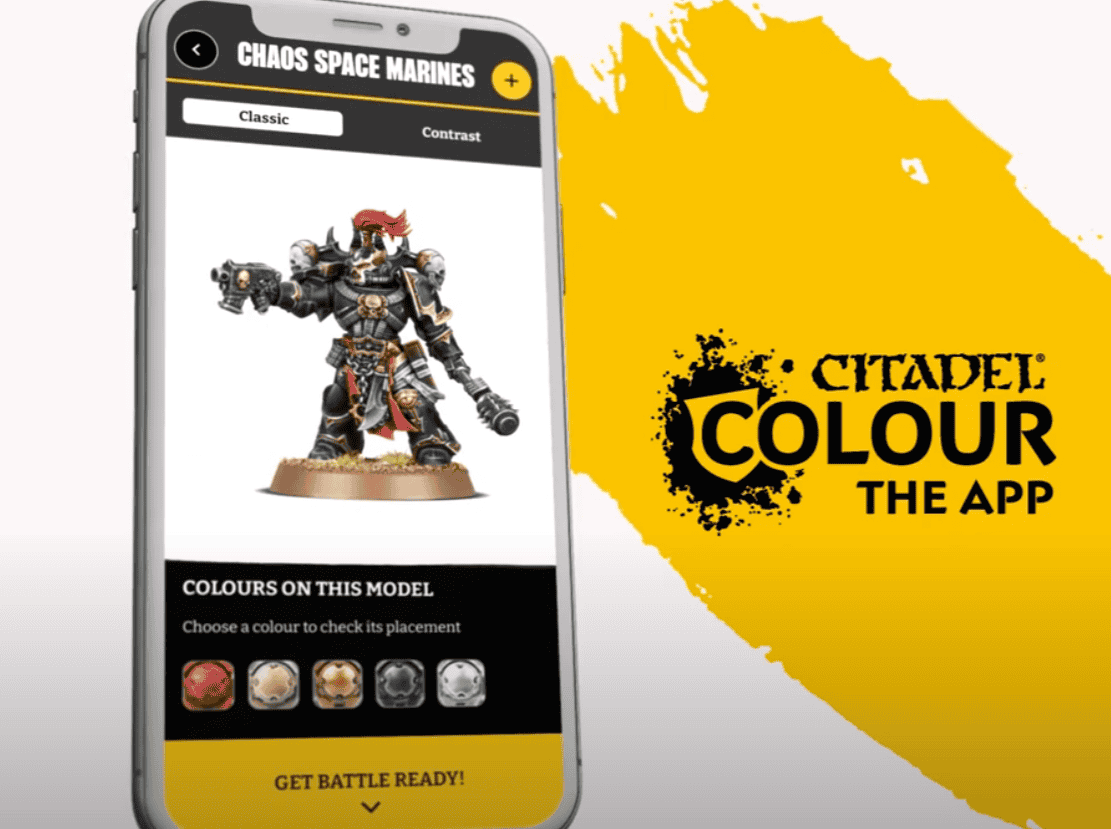
The Citadel Paint App is like carrying the whole Citadel paint catalog in your pocket. This app isn’t just a color chart—it’s an interactive tool that helps you plan your entire painting process. Want to see how your selected base color will look with different shades or highlight combinations? The app has you covered with its intuitive color-matching tools and guides for perfect layering.
Army Painter Color Chart & Paint Conversion

Army Painter has earned its place in the hearts (and paintbrushes) of miniature painters everywhere, and for good reason. First up, it’s affordable. You can stock up on an entire range of colors without having to sell your prized Space Marines on eBay.
For hobbyists who churn through colors faster than they can prime their miniatures, this affordability is a game-changer. But affordability isn’t Army Painter’s only selling point. It’s also widely available, making it easy to grab a few bottles from your local game store or online retailer, ensuring you’re never stuck waiting for that crucial pot of “Goblin Green.”
One thing that sets Army Painter apart is how seamlessly it integrates with color-matching primers. This clever system saves hours by matching your primer to your main color, meaning fewer coats and smoother finishes. So, if you’re a fan of efficiency (or just impatient), Army Painter might just be your new best friend.
Types of Paint in the Army Painter Range
Army Painter offers three main lines of paint, each tailored to a specific stage of painting or technique.
- Warpaints Fanatic: These are your bread-and-butter acrylics, designed for base coating and layering. The colors are rich, smooth, and provide good coverage with a few strokes. Whether you’re painting an orc horde or a legion of Stormtroopers, Warpaints have you covered.
- Speedpaints: These little miracles give you contrast-level results in a single coat. Much like Citadel’s Contrast paints, Speedpaints pool in the recesses and highlight raised areas with minimal effort. Perfect for batch-painting your way through a mountain of miniatures while still looking like you spent hours on each one.
- Quickshade: This range is Army Painter’s answer to shading, designed to add depth and dimension. Think of it as liquid talent—just slap it on and let it work its magic. It’s like adding instant shadows without needing to learn advanced painting techniques.
Army Painter Conversion Color Chart (Warpaints Discontinued)

The Army Painter conversion chart is a lifesaver when you’re looking to match colors across different brands. Whether you’re switching mid-project because you ran out of “Dragon Red” or just prefer using Vallejo’s famous dropper bottles, the chart makes it easy to find equivalents.
It’s as simple as finding your color in one brand and matching it to the closest shade in another. No more guessing and hoping the results don’t look like an accidental color experiment gone wrong.
Warpaints Fanatic Paint Conversion Chart
If you’ve upgraded from The Army Painter’s original Warpaints to the shiny new Warpaints Fanatic range, you’re probably asking yourself, “How do I match my old colors to these new ones?”
Good news: The Army Painter’s got your back with a Fanatic Conversion Chart that’s as handy as it gets. This chart makes the whole process simple, giving you a reliable guide to keep your favorite minis looking cohesive and downright impressive.
The Fanatic Conversion Chart doesn’t just stop at matching old Warpaints to the Fanatic range—it also includes handy comparisons for Warpaints Air and even Citadel paints from Games Workshop. It’s like the ultimate cheat sheet for painters juggling multiple ranges.
Army Painter to Citadel to Vallejo Paint Color Chart Matches
One of the most useful aspects of the Army Painter conversion chart is how it helps bridge the gap between Citadel, Vallejo, and Army Painter paints. For instance, if you love Citadel’s “Mephiston Red” but only have Army Painter at hand, “Dragon Red” will give you nearly the same intensity. On the Vallejo side, their “Gory Red” is a solid match.
Need to match a Citadel Contrast color? Speedpaints have you covered. For example, Army Painter’s “Blood Red” Speedpaint is comparable to Citadel’s “Blood Angels Red” Contrast paint, giving you similar results without the stress of color-matching on your own.
Vallejo Paint Charts & Conversions Guide
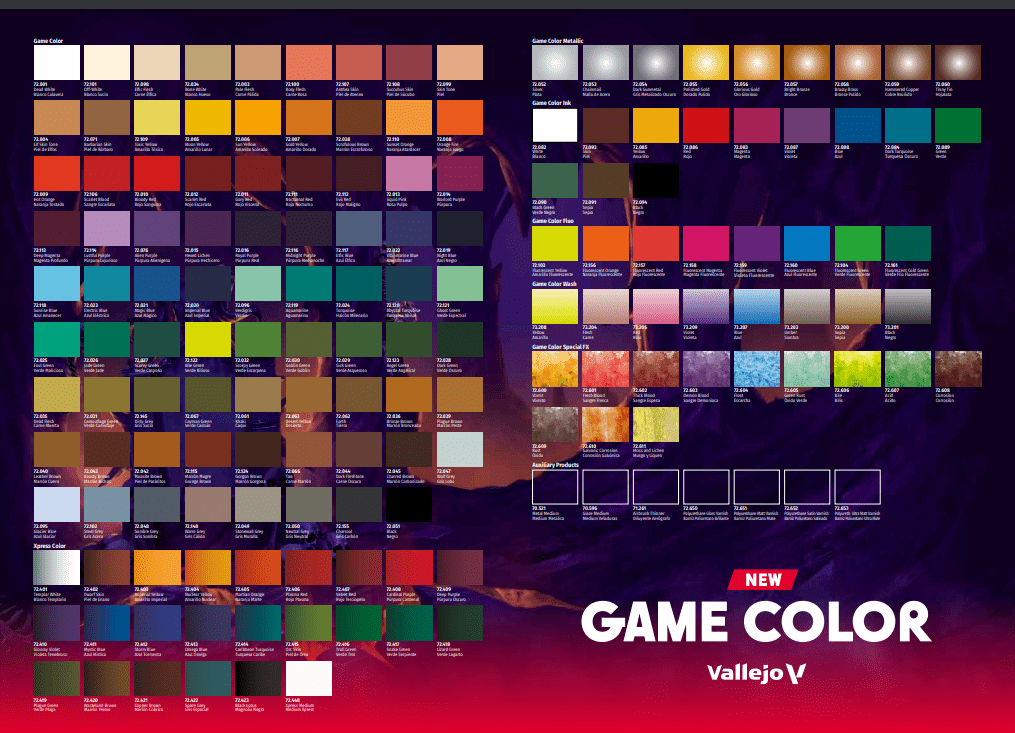
In 2024, a strike marred Vallejo’s reputation when many inhumane accusations were made against the firm, which eventually agreed to all the worker’s demands after a month.
Currently, Vallejo paints come in three main varieties:
- Game Color: These are designed specifically for miniature painting, offering bright, vibrant colors perfect for sci-fi and fantasy minis. Whether you’re looking to make an Eldar glow or a Space Marine shine, Game Color has the vibrancy you need.
- Model Color: For those who prefer a more realistic tone, especially for historical miniatures, Model Color is where Vallejo truly excels. The range is packed with muted, realistic colors that replicate real-world uniforms, armor, and vehicles.
- Vallejo Air (Airbrush): Vallejo’s Airbrush paints are pre-thinned and ready to go right into your airbrush, offering smooth, even coverage for those larger projects.
Why Vallejo Paints are Favored for Miniatures
Vallejo’s dropper bottles are a painter’s dream. Gone are the days of accidentally spilling half a pot of paint all over your palette—just squeeze out the perfect amount with Vallejo. Plus, the bottles are airtight, so your paints won’t dry out after a couple of uses (looking at you, Citadel).
Price-wise, Vallejo offers excellent value for money, with a price-per-ml that’s hard to beat. You get more paint, better control, and fewer drying accidents, all while saving a few bucks. What’s not to love?
Vallejo Paint Conversion Chart
Vallejo’s conversion chart is a handy reference for cross-referencing colors with other brands. If you’ve started a project with Citadel but prefer Vallejo’s dropper bottles or price, the chart helps you find equivalent colors so your army doesn’t look like a patchwork of mismatched hues.
Converting Vallejo Colors to Citadel and Army Painter
Converting between Vallejo, Citadel, and Army Painter can be as easy as consulting the conversion chart. If you’re out of Citadel’s “Averland Sunset,” no worries—Vallejo’s “Gold Yellow” has you covered. Similarly, Army Painter’s “Daemonic Yellow” offers a good match if you prefer their line.
Whether you’re going from Vallejo to Citadel or Army Painter to Vallejo, these charts are an indispensable tool for ensuring your models look as cohesive as you imagined.
Comprehensive Paint Conversion Charts: Citadel, Army Painter, Vallejo
These handy guides allow you to match colors between different brands, so if your Citadel “Mephiston Red” dries up mid-project, you can find its Army Painter or Vallejo twin without breaking a sweat.
Duncan Rhodes’ Two Thin Coats Conversion Chart

Want to swap your Citadel Mephiston Red for a Two Thin Coats match? Boom—Doomfire Red is your new bestie. Each column lovingly cross-references brands, so you don’t need to play guess-the-shade anymore.

Colour Forge
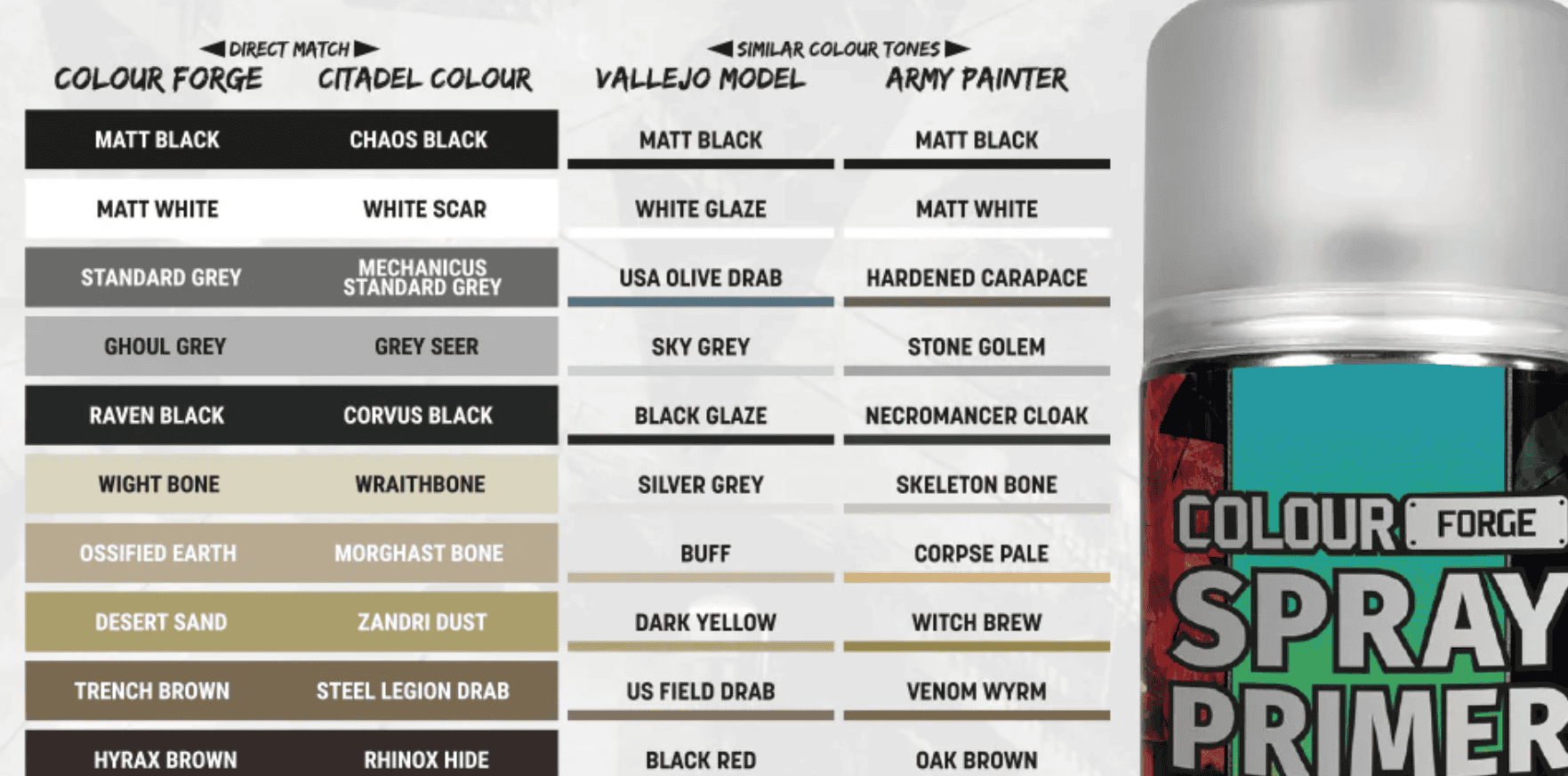
Trying to trade in your Citadel Macragge Blue for a Colour Forge equivalent? No problem—Republic Blue has your back. The chart lines up paints across popular brands, so you can switch systems without playing chromatic roulette.
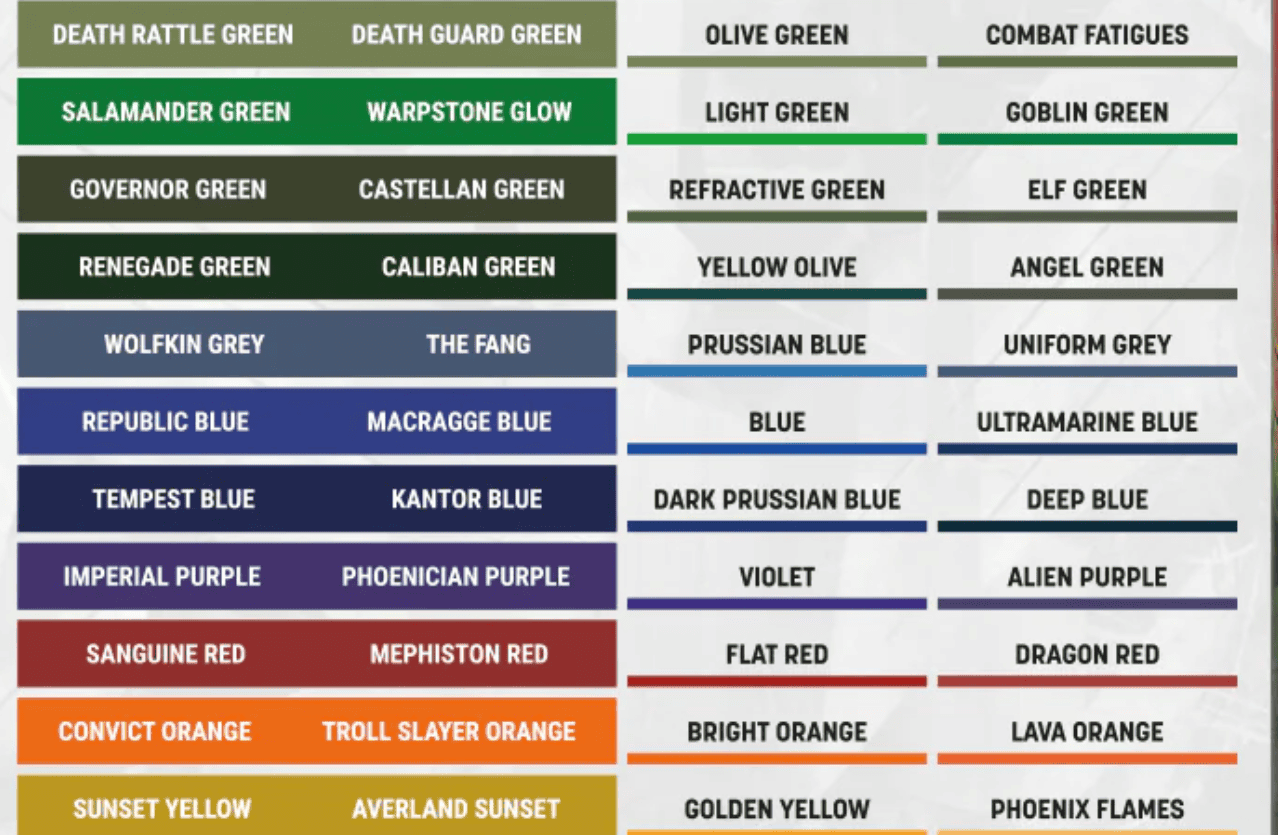
Special Paint Ranges & Their Place in Conversion Charts
Specialty Paints: Turbodork, Scale75, Pro Acryl, and More
If the traditional colors feel a bit too… traditional, there’s a whole universe of specialty paints waiting for you.
Brands like Turbodork, Scale75, and Pro Acryl (affiliate links- thanks) bring unique pigments into the mix, and they’ve quickly gained cult status among painters who want their miniatures to stand out on the battlefield.
Unique Color Ranges Like Metallic and Chameleon Paints
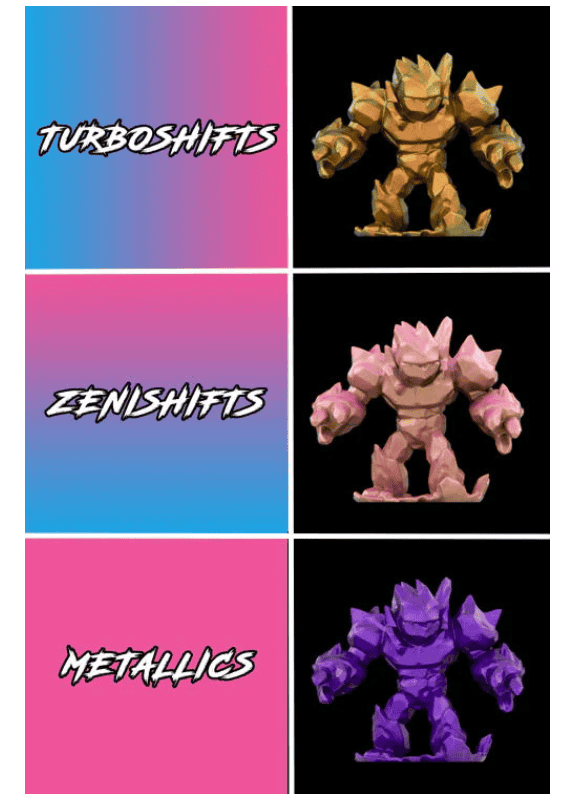
Turbo Dork’s metallics have a wild effect that can change the look of your army in minutes!
Matching Specialty Paints to Traditional Paint Lines
Of course, with great uniqueness comes great responsibility. Matching specialty paints to traditional ranges is trickier, but not impossible. Conversion charts often list matches that are close in color but note the differences in finish or opacity.
For example, Pro Acryl’s smooth, matte finish might not have a perfect equivalent in Citadel’s shiny metallics, but a conversion chart can help you get as close as possible. For chameleon or metallic paints, you’ll often need to eyeball the match or layer traditional paints with washes or glazes to get that otherworldly effect.
Finding the Right Paint Match for Your Miniatures
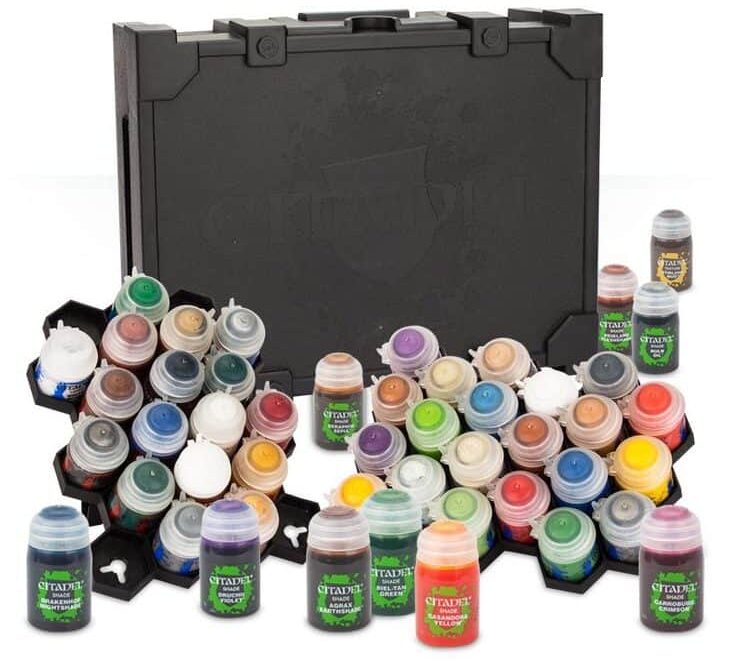
Best Practices for Using Conversion Charts in Your Projects
When using a conversion chart, keep these tips in mind:
- Test first: Never skip the test mini stage, because it saves a lot of headaches in the long run.
- Factor in finish: If you’re switching from matte to gloss, be prepared for a slightly different look.
- Check the brand differences: Some brands, like Vallejo, tend to be more pigment-heavy, so a little goes a long way. Others, like Army Painter’s Speedpaints, are designed to act differently on the mini’s surface.
Final Thoughts on Paint Conversion Charts for Miniature Painters
While conversion charts are an essential tool, they’re not always 100% perfect. It’s always a good idea to test your new paint on a spare mini or a piece of sprue to see how it dries and looks in natural light. Sometimes, a perfect match on paper might need a little tweaking with some layers or washes to get it just right for your unique project.
With these color charts at your side, you’ll be able to tackle any paint conversion challenge that comes your way with Citadel or any other brand of paint.
The Best Acrylic Model Paint for Miniatures
What do you think about the Citadel, Army Painter, and Vallejo paint color conversion chart?
